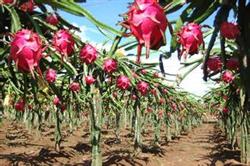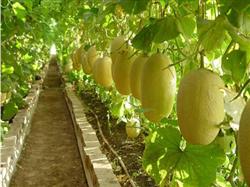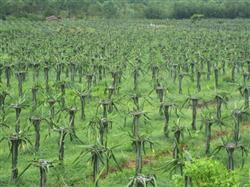Rational cultivation of dragon fruit to achieve high yield

1. Choose a place. The dragon fruit is resistant to drought and humidity, and is afraid of low temperature. It can be planted in areas with an annual average temperature of more than 20 ℃. The slopes with good drainage, fertile and loose soil layer, good aggregate structure but not sandy loam, sandy loam and clay loam should be selected for planting. Soil moisture should not be too high, ventilation should be good, otherwise it is easy to rot roots and seedlings. two。 Set up a pillar. The dragon fruit should have a support to make it climb up, and the branches will naturally droop when they reach the top, so that the hanging branches can easily become fruiting branches. The support should be firm and durable. Pitaya is planted in a variety of ways, some climb the wall, some set up a shed, but column cultivation is the most common, with low production cost, convenient management and high land utilization rate. Generally speaking, dragon fruit growers mainly use cement column support. The cement column is 2.5 × 2.5 meters apart, with 110 columns per mu. The cement column (specification 8 × 8 × 210 cm) is buried 50 cm underground and 160 cm high above ground. A motorcycle tire ring of about 60 cm is fixed on the top of the cement column for the growth of branches. After the cement column was set up, 4 pitaya were planted around the column and 440 per mu. 3. Raising seedlings and planting. Seedlings were raised by ①. Dragon fruit seedling is a kind of grafted seedling, rootstock with sword flower (overlord flower), and then with dragon fruit scion. The 30cm-long pseudostem of Jianhua was first planted and grafted after the pseudostem germinated, and it could not be transplanted and planted until half a year later. ② colonization. Open terraces for planting on gentle slopes. After the planting point is determined, leave the inside 1 meter in the row spacing of 3 meters as the walkway, and the support frame and the foot of the cement column are 2 meters wide as the planting bed, with a height of 40 centimeters. Apply some farm manure, granular organic fertilizer and so on in the border and mix with the soil. The planting density of dragon fruit is 2.5 × 2.5 meters between rows, 2 plants in each hole, and the planting depth is 5-7.5 cm. After the seedlings are implanted, cover the topsoil and press the seedlings slightly. Do not plant the seedlings upside down. After planting, it is necessary to water the roots once, watering once every 2 to 3 days at the initial stage, and then keep the soil moist. It can also spread some straw and rice husk on the surface to inhibit the growth of weeds and moisturize. 4. Fertilizer and water management. Dig a pit with a length, width and depth of 0.3 × 0.3 × 0.1 meters around the climbing column. 25 kg of pig manure or chicken manure, 1 kg of phosphate fertilizer, 0.5 kg of compound fertilizer and 1 kg of lime were applied in the pit, which were mixed with soil and supplemented with microbial compound fertilizer. After the dragon fruit plant begins to grow normally, it can be applied with thin fertilizer or organic fertilizer, once or twice a month. In the growth stage, nitrogen, phosphorus and potassium should be balanced, should not be partial to nitrogen fertilizer, and should be dominated by phosphorus and potassium fertilizer after flowering and fruiting. In addition, 300-fold solution of potassium dihydrogen phosphate can be sprayed on leaves all the year round. The dragon fruit has high yield, and the fruit production period is as long as 6 months, which is matured in several batches, so that it can meet the nutrients needed for the growth and development of dragon fruit. 5. Pollination, flower thinning and harvest. Dragon fruit has red meat and white meat. The white flower seed setting rate of white meat type varieties can reach 98%, while the self-flowering compatibility of red meat type varieties is poor. In the peak period of flower and fruit, there are quite a lot of buds, and sometimes there are nearly 30 buds on the same branch. It is necessary to remove the extra buds within 8 days of seeing the buds, leaving only 1 or 2 buds per branch. Pollination is suitable from 10:00 at night to 1: 00 the next day, take the pollen of male flowers and apply them on the stigma of female flowers with a brush. From 26 to 27 days after flower fade, the pericarp began to turn red, and after 7 to 10 days, the appearance of the fruit was bulging and round, and it could be harvested when it appeared glossy. During harvest, part of the stem flesh is cut off from the pedicel, and the pedicel is retained as far as possible. The fruit with pedicel is more resistant to storage. 6. Pest control. The main purpose of the seedling stage is to control snails, slugs and caterpillars, and lime, plant ash or poison bait can be used to kill trees. Insecticides can be used when caterpillars occur seriously. Generally, about 3 cm was extracted from the new shoots to start spraying, with 90% trichlorfon or 80% dichlorvos plus 50% dimethoate 1000 times, 20% fenpropathrin or 2.5% deltamethrin 2000 times 3000 times, 50% Daofeng powder 1000 times, once in 7 days and 2 times in a row. The fruit can be bagged in the middle stage of fruit development to prevent fruit flies from eating pulp. 7. Pruning and reproduction. At the end of the growing season, all the old branches that have borne fruit and are pulled perpendicular to the ground by the fruit should be cut off. When the dragon fruit is in full bloom, the excess nutrient branches can be cut off at flowering stage to reduce shading and nutrient consumption. The cut branches can be used for cutting seedlings. When cutting, cut the branch into about 30cm, put it in a cool and ventilated place and wait for sand cutting or direct cutting under the support frame and the side of the cement column after the wound is dry. It can be carried out at any time except during the frost period. After cutting can not be watered, the soil should be dry, 10 days after planting before watering. 8. Replanting, pruning. For individual planting holes with weak growth, new seedlings should be planted to increase the annual yield in the coming year. It is necessary to cut off the fruiting old branches and weak growth branches so as not to consume nutrients and affect the yield.
- Prev

Integrated control measures of Hami melon vine blight in rainy area
First, bacterial leaf spot symptoms: in the early stage, waterlogged disease spots appeared near the veins of the dorsal leaves, which expanded rapidly and became one, with yellow halos on the edges. Prevention and treatment: at the initial stage of the disease, 77% Dorin 500 times or 3% Zhongshengmycin 800 times foliar spray 2-3 times, once every 4-5 days. Second, vine blight disease.
- Next

Irrigation and drainage of dragon fruit (part two)
(2) Irrigation method and irrigation quantity ① flooding irrigation is often carried out in the area with abundant water sources and flat terrain. However, this method has a certain degree of damage to the soil structure, labor-consuming and time-consuming, and uneconomical, so it has been gradually reduced. ② border irrigation by plant as a unit to repair the tree plate, or along the tree line to make a long border, irrigation.
Related
- Moge, come on! The staff of the peasant association in the producing area of cantaloupe were frightened when the crowd gathered.
- Causes and Solutions of low Fruit setting rate of Apple
- Symptoms and control measures of passion fruit virus disease
- Fruit growing lesson: how do apple orchards keep high yields?
- Can you build orchards in the mountains? What are the pros and cons?
- How to manage the coloring period of Crisson grape?
- This paper introduces the processing technology of two kinds of fig products.
- How much is a month for retired teachers in rural areas by 2020?
- How can strawberry planting increase sugar content? We should pay attention to management in many aspects.
- What are the cultivation techniques on how to improve the yield of golden fruit?

